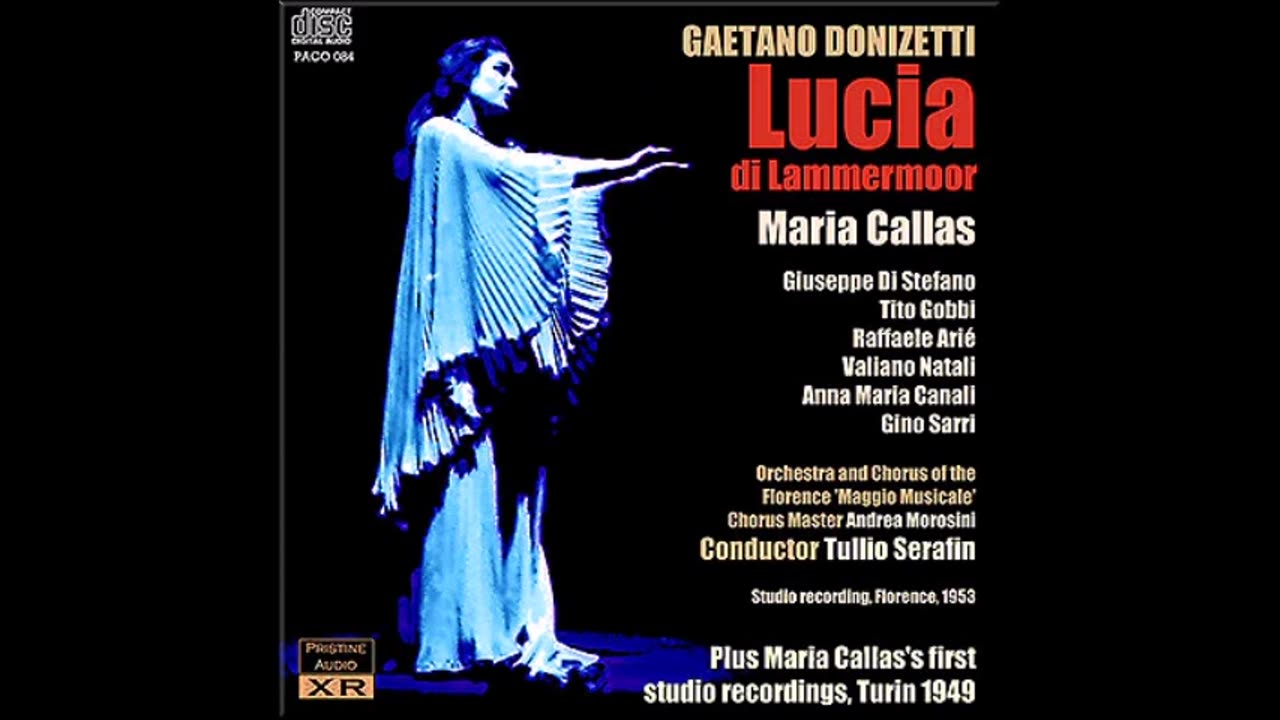Premium Only Content

Lucia di Lammermoor by Donizetti reviewed by Roger Parker 10th May 2025
Lucia di Lammermoor by Donizetti reviewed by Roger Parker 10th May 2025
Top choice:
Maria Callas (Lucia)
Giuseppe Di Stefano (Edgardo)
Tito Gobbi (Enrico)
Raffaele Arié (Raimondo)
Valiano Natali (Arturo)
Anna Maria Canali (Alisa)
Gino Sarri (Normanno)
Chorus and Orchestra of the Maggio Musicale Fiorentino
Tullio Serafin (conductor)
Naxos 8.110131-32
CALLAS Donizetti: Lucia di Lammermoor & First studio recordings (1953/1949) - PACO084
Regular price€30.00
• €30.00 - Ambient Stereo 24-bit FLAC€30.00
• €18.00 - Ambient Stereo 16-bit FLAC€18.00
• €18.00 - Mono 16-bit FLAC€18.00
• €14.00 - 320kbps Ambient Stereo MP3€14.00
Overview
DONIZETTI Lucia di Lammermoor
Studio recordings, 1953 and 1949
Total duration: 2hr 12:58
Maria Callas - Lucia
Giuseppe Di Stefano - Edgardo
Tito Gobbi - Enrico
Chorus & Orchestra of the Maggio Musicale, Florence
Tullio Serafin, conductor
Orchestra Sinfonica di Torino della RAI
Arturo Basile, conductor
Callas: The early recordings - her first EMI opera, her first studio sessions
Massive sonic overhauls from the vocal gems that launched a legend
This recording of Lucia di Lammermoor was Maria Callas's first opera for EMI, and one of very few of her classic 1950s EMI opera recordings not made in Milan with the orchestra and chorus of La Scala. It was her second full opera recording, and only her third official studio recording session. Despite some major cuts in the score, it was hailed on its release, with A.R. writing not only praise for Callas in his review in The Gramophone: "Much credit is due to Tullio Serafin for his admirable direction of the opera and to the engineers for a most excellent recording".
From a technical perspective the original recording is interesting. Despite at times being apparently unremittingly dry, occasionally we do get a sense of space and acoustic. Equalisation favours clarity of voice above all, and there is a real lack of depth in the sound (and, it turns out, a lot of murk and muck in the lower registers). Working on these two areas in particular rounds out the sound of the male voices in particular, making their previous incarnations sound somewhat impotent, as well as giving the orchestra a far more convincing presence. But of course it is Callas who shines here, and with the slightest cushioning of real opera house acoutics (in this case I found the Sydney Opera House to offer the most accommodating sound without sacrificing the clarity of the original recording) she sounds more ravishing than ever.
A quick note about the early Callas recordings: in cleaning these up I discovered low-pitched 50Hz mains hum which suggested an unusually high orchestral pitch (A4=-~460Hz) running throughout the three direct-to-disc 78rpm sessions. Repitching the recordings from standard 440Hz by using this reference immediately relieved them of an unusual heaviness of voice and sounded very convincing. Despite this reamrkable degree of sharpness I elected to believe that what my measurements and ears were telling me was indeed correct.
Andrew Rose
-
 2:04:24
2:04:24
FreshandFit
12 hours agoGianni Blu Meets 305
217K10 -
 2:37:35
2:37:35
Badlands Media
13 hours agoDEFCON ZERQ Ep. 014: Marker Nine – The Ninth War Is Coming
73.7K71 -
 2:10:43
2:10:43
Inverted World Live
9 hours agoTop General Outsourcing Decisions to ChatGPT | Ep. 127
86.8K9 -
 2:46:27
2:46:27
Laura Loomer
9 hours agoEP151: Democrats Meet With Terror Tied Islamic Group During Government Shutdown
29.8K21 -
 3:02:06
3:02:06
TimcastIRL
8 hours agoPortland Police PROTECT Antifa From DHS Arrest, Trump Admin Says SEND IN THE GUARD | Timcast IRL
232K131 -
 2:49:50
2:49:50
Barry Cunningham
8 hours agoPRESIDENT TRUMP SPEAKS TO THE PRESS...NO DEALS! DO YOU CARE IF THE GOVERNMENT STAYS SHUT DOWN?
45.4K39 -
 1:37:24
1:37:24
Tundra Tactical
6 hours ago $16.51 earned🚨🚨Emergency Gun News!!!!🚨🚨 Did Glock Just Cave To Liberal Pressure?? Current Glocks Done?
34.6K4 -
 1:02:57
1:02:57
Sarah Westall
10 hours agoStructure of the World has Changed and Getting Back to Basics w/ Stacy Washington
49K10 -
 6:34
6:34
Buddy Brown
11 hours ago $11.75 earnedWatch What Happens When WELFARE QUEENS Get Denied FOOD STAMPS! | Buddy Brown
41.6K28 -
 5:02:12
5:02:12
Drew Hernandez
18 hours agoCHARLIE KIRK TRIAL JUDGE ISSUES GAG ORDER & U.S. MARSHAL ILLEGAL ALIEN SHOOTOUT?
47.7K10